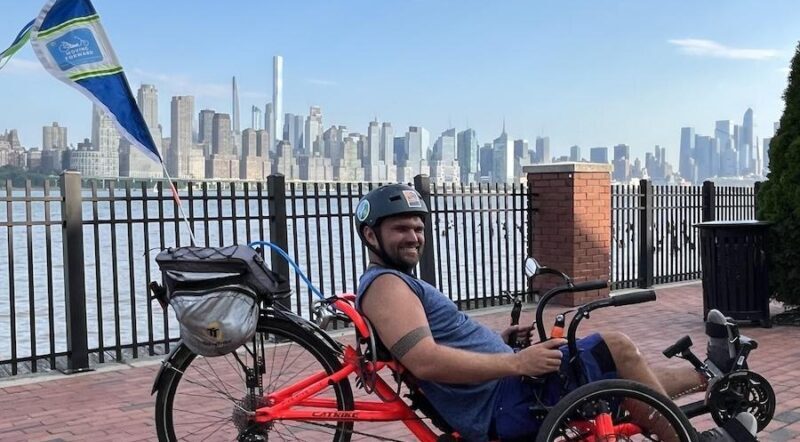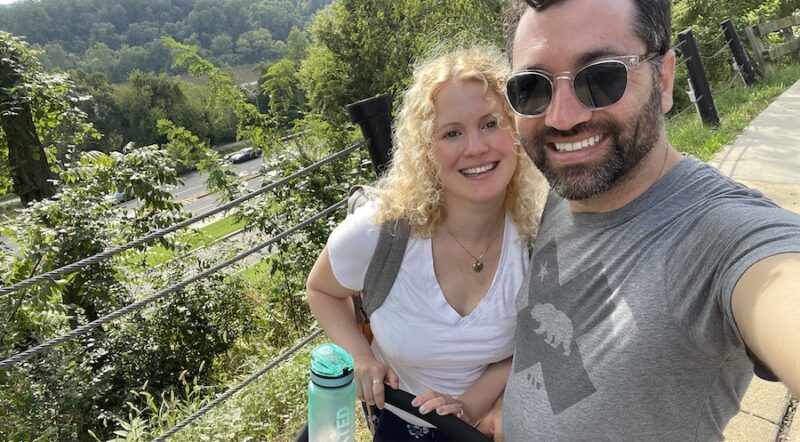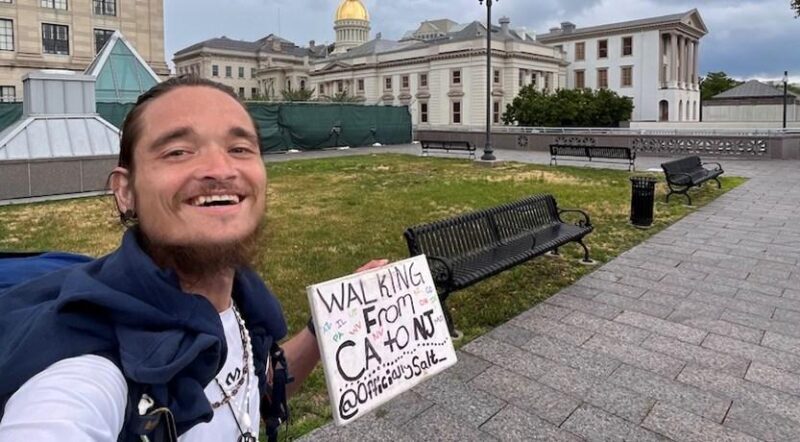Accessibility
Delaware & Lehigh Trail | Photo by Thom Carroll
Note: This page mainly focuses on accessibility resources for rail-trails and other multiuse paths, defined as ‘shared use paths’ in accessibility guidance. For information on accessible pedestrian trails, hiking or mountain biking paths, see American Trails.
Read RTC’s recent letter in support of the Adoption of the Accessibility Guidelines for Pedestrian Facilities in the Public Right-of-Way.
When most people go out on the trail, they are looking to have fun, be healthy, enjoy nature and bond with friends and family. This is true—regardless of one’s age or ability. Accessibility is a crucial aspect of trail development, because it is key to ensuring that trails are available to everyone, including young people, older adults and people with disabilities.
There are 61 million adults in the United States living with a disability. That’s 1 in 4 adults, according to Centers for Disease Control and Prevention (CDC) figures. For adults over 65, that number rises to 2 in 5. Disabilities can be mobility related, or take the form of cognitive impairments or sensory impairments related to vision or hearing, for example.
As the National Center on Accessibility states in its National Trail Surface Study, “Attitudes, inaccessible environments and a limited of understanding of possibilities prevent individuals from leisure and recreation.” Trails need to be planned and designed in an inclusive way so that people of all ability levels have safe and fun experiences out on the trail.
Designing and Building Accessible Trails
This webinar summarizes PROWAG for shared-use paths, talks about federal funding for accessibility interventions on trails, and explores the accessible designs on two Philadelphia trail segments.
Because trails are transportation and recreation facilities, accessibility is mandated by the federal Americans with Disabilities Act of 1990 (ADA), which requires certain design standards for facilities to be in compliance with the law. ADA compliance is important to keep in mind as a trail enters the design and construction phases. Many rail-trails are ADA compliant; for an example, see Ohio’s Little Miami Scenic Trail.
Federal and federally funded facilities must be in conformance with the Architectural Barriers Act Accessibility Standards. The Americans with Disabilities Act provides that any public-facing programs of a covered entity (Title II – State & Local Government or Title III – Non-Profits, Commercial Facilities, and other Public Accommodations) must be accessible to people with disabilities. Therefore, trail managers have an obligation under the law to ensure their facilities, programs and services are accessible by people with disabilities.
In 2013, the Access Board announced that it will supplement its rulemaking on public rights-of-way to include shared used paths—pedestrian and bicycle facilities designed for recreation and transportation that are physically separated from roadways (many rail-trails are considered shared use paths). The Board proposes to apply forthcoming guidelines to shared-use paths to ensure these facilities are accessible to, and usable by, individuals with disabilities. The Public Rights-of-Way Accessibility Guidelines, while not yet legally enforceable, are already considered best practices and have been incorporated into current design guidance. For instance, the Florida Greenbook, which is the manual that governs the design of local roads, sidewalks and shared-use paths in Florida requires all shared-use paths to be accessible and specifically incorporates many of PROWAG’s requirements into its criteria.
Accessibility matters beyond the trail itself. The trailhead is the first encounter a user has with the trail and sets the tone for the trail experience. Built elements such as visitor centers, parking areas and restrooms should conform to the ADA accessibility guidelines for buildings and sites. Because people with disabilities engage in every type of trail activity—from walking and bicycling to equestrianism, snowmobiling and more—facilities designed to cater to these uses must be accessible.
Another crucial site is the connection from the trailhead to the entrance of the trail—and this is often where accessibility can breakdown. Barriers such as gates and bollards are often uses to keep unsanctioned activities from happening on the trail, but they can compromise access to the trail for wheelchair users. It is imperative that these elements are constructed to ensure accessible entry for all users. Trailside amenities and destinations (e.g., an overlook, a beach, etc.) should also be constructed to an accessible standard since they help form part of the overall trail experience.
Finally, keeping the trail well maintained is essential for accessibility, as wear to the surface can make a previously accessible trail unsafe or difficult to use.
Luckily, it’s not difficult for many rail-trails to become ADA compliant due to their wide, paved/developed surfaces and gentle slopes, and there are also numerous resources to guide trail builders. As part of a presentation in 2007, Alta Planning + Design produced a short slideshow on ADA access for trails and greenways, which offers a helpful introduction to the subject. The Federal Highway Administration has published “Designing Sidewalks and Trails for Access” (Part I and Part II), a useful guide to help navigate some of the details of ADA compliance. A good resource for more in-depth assistance is the ADA National Network, a coalition of 10 regional centers offering technical assistance on ADA issues.
Which guidelines should I use for my trail and trailside facilities? Webinar panelist Christopher Douwes provided this handy summary for reference
ADA compliance is just a starting point, and many groups go above and beyond to reduce physical barriers to participation on their trails. Thinking experientially (how would X experience this trail?) is likely to move trail planners past simple ADA compliance and toward inclusive recreation experiences for trail users of all abilities.
Planning for Accessibility
Well before trails and trail facilities are constructed, accessibility should be prominently included in the planning phases. As a matter of routine, planning meetings for trails should be held at accessible venues—and with any other necessary accommodations—so that people with disabilities can fully participate in community and coalition meetings held during the planning process. Good practice is to gather attendee needs ahead of time and follow up to ensure the appropriate provision of accommodations such as sign language interpretation, wheelchair access, preferred seating and captions. Checklists and guidance for holding inclusive and accessible meetings—in person and virtually—can be found online at Section 508.gov and the Mid-Atlantic ADA Center.
Trail planners may have to proactively seek out perspectives of trail users with disabilities by reaching out to advocacy organizations, independent living centers and veterans affairs offices. Some municipalities and counties have an accessibility coordinator or office of persons with disabilities—either standalone or housed within another department such as parks or transportation. Planners and trail advocates should also consider creating a disability advisory group, made up of people living with disabilities and/or working within the space, who can provide knowledgeable feedback and speak from experience.
Trail organizations should include a range of trail users and people of different abilities in their marketing materials. Likewise, trail groups should ensure their trail programming is inclusive for all users. Intentional representation sends an important and meaningful message of welcome.
Rules and regulations on the use of personal mobility devices on trails vary by locality; however, federal law and ADA regulations permit people with mobility issues the use of assistive devices in any area open to pedestrian traffic, and service animals in any setting except where there may be legitimate safety concerns or fundamental alterations to services.
It’s important to educate trail users and staff alike on these regulations as well as other mobility devices permitted for use to avoid negative interactions and situations of harassment on trails and greenways. For example, while there is no consensus on the use of e-bikes on trails, and they are not currently classified as Other Power-Driven Mobility Devices (OPDMD), some people—including those with mobility issues or recovering from injuries—might prefer to use them for the pedal-assist benefits. Along the Blackstone River Greenway in Massachusetts, trail users can rent an electric-assist wheelchair bike, which allows people with mobility impairments to sit in the front of the bike while someone peddles behind them. The bike is available in the springtime through All Out Adventures, an organization that specializes in providing outdoor programming for persons with disabilities and their families and friends.
Knowledge is power
One of the most important things a trail manager can do is to ensure information about their trail is readily available to users both at the trail and online. The more detailed, the better. Beyond physical alterations to the trail or its amenities, ensuring adequate information about a trail can be a quick win for increased accessibility, as advanced knowledge of potential barriers to mobility—or lack thereof—can make or break the trail experience. Unfortunately, researching trails can often be a frustrating and futile exercise.
It’s important to not make assumptions about what people may or may not be able to handle. What is accessible or easy to someone may not be to another person. Trail managers can begin by providing objective and comparable information, including:
- Length
- Surface type(s)
- Typical and minimum trail width
- Typical and maximum running slope
- Typical and maximum cross slope
- Obstacles over 2 inches high
- List of accessible features (e.g., parking, restrooms, benches, etc.)
This information can be included in signage at the trailhead, for example. Additional details like trail descriptions, photos and user reviews are even more helpful for informing visitors of what to expect. While experiencing the trail in person is really the best way to know whether it truly meets one’s accessibility needs, a person can use the information available to make a judgment call about whether or not to attempt the trail.
TrailLink, a service of Rails-to-Trails Conservancy, provides information on an estimated 40,000 miles of multiuse trails, including hundreds of wheelchair-accessible trails across the United States. The trail pages include descriptions, photos and reviews. Both trail managers and trail users can submit information about accessibility and other aspects of the experience directly to the website.
The National Audubon Society’s Birdability initiative seeks to make birding “welcoming, inclusive, safe and accessible for everybody.” The initiative was started by Virginia Rose, an avid birder and wheelchair user, and provides advocacy and education to make birding more accessible to people living with mobility, sensory and cognitive disabilities. Birdability provides free resources on its website that cover topics such as how to make birding outings more inclusive and the use of inclusive language. It also provides guidance and a checklist for assessing the physical accessibility of birding locations (such as parks and trails) and invites users to submit that information to their Birdability map.
Definitions
Shared use paths -multi-use paths designed primarily for use by bicyclists and pedestrians, including pedestrians with disabilities, for transportation and recreation purposes. These paths typically have a machined, layered surface (i.e., asphalt, concrete, bonded materials, other), and are located in either an “independent corridor” or public right-of-way. Accessibility guidance is found in the proposed Public Rights of Way Accessibility Guidelines (PROWAG). Rail-trails and other multiuse trails are shared use paths. At RTC, when we say trails, we mean shared use paths.
Trail – According to the Architectural Barriers Act (ABA) Standards, a trail is a pedestrian route developed primarily for outdoor recreational purposes. Pedestrian routes that are developed primarily to connect accessible elements, spaces, and buildings within a site are not a trail (see accessible route). Technical guidance for these types of facilities can be found in Chapter 10 of the ABA Standards. Rail-trails and multi-use trails are Shared Use Paths, under PROWAG.
Accessible Route – Connects accessible elements and spaces of a building or facility on a site.
Accessibility Stories
View More BlogsResources
‣ Webinar – Accessibility on Rail-trails and other Shared Use Paths
‣ Webinar – Accessible and Inclusive Events and Programs on Multiuse Trails
‣ Report – Rails-with-Trails: Best Practices and Lessons Learned (2021)
‣ Report – Accessibility Toolkit for Land Managers (2020)
‣ Manual – 2010 ADA Standards for Accessible Design
‣ Manual – National Trail Surfaces Study
‣ Manual – ADA Access on Paved Bikeways
‣ Manual – Soil Stabilizers on Universally Accessible Trails
TrailNation Collaborative
TrailNation™ Collaborative is a nationwide peer learning community from Rails to Trails Conservancy that brings together advocates, leaders and professionals from across disciplines to establish and accelerate trail networks across America. The collaborative provides proven tools, methods and resources, combined with RTC’s expertise and network of partners across the country, to accelerate the development of connected trail systems. When trails are connected across regions and states, trail networks have a proven transformative impact—they are essential infrastructure that creates thriving, healthier communities.


